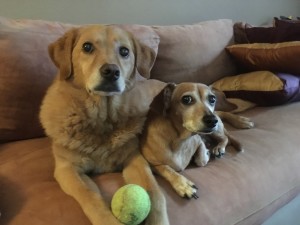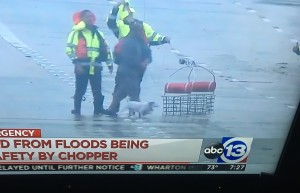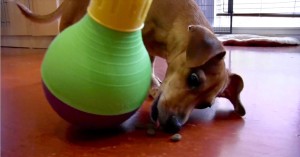Michael Baugh CDBC CPDT-KSA
Hurricane season ends November 30th, and not a moment too soon. This season was particularly brutal, with three major hurricanes hitting U.S. shores in less than a month. The most impactful for us in Houston, of course, was Hurricane Harvey.
 The storms this year, and Harvey in particular, got me thinking long term about what we all need to teach our dogs so that we are well prepared for next year’s hurricane season and the ones to follow. These aren’t quick fix tips. This is a training challenge for all of us for the next six-months ahead. What can we do now so that our dogs are best prepared if the worst happens – again?
The storms this year, and Harvey in particular, got me thinking long term about what we all need to teach our dogs so that we are well prepared for next year’s hurricane season and the ones to follow. These aren’t quick fix tips. This is a training challenge for all of us for the next six-months ahead. What can we do now so that our dogs are best prepared if the worst happens – again?
The Hurricane Dog Training Challenge.
Potty Training. During the many long nights and days of Harvey’s deluge, I got more texts and emails about dogs not wanting to go outside to potty in the rain than any other subject. There were few easy answers at hand. We were in the middle of a crisis, all of us including my dogs and I.
One former client posted this great photo of sod she’d purchased and put under her carport. It’s a great solution if you’d thought of it ahead of time.
I leveraged a cue I’ve taught my dogs: “go outside go potty” to get them revved up and out the door. This rather dark video is an example from Sunday Night in the storm.
The Training Challenge: Retrain Potty training with a cue for going going out. Here’s a link to my potty training handout for your review. And here’s a link to my potty training video. Be sure to add the cue, as I did.
Crate Training. Thousands of dogs (yes thousands) ended up at the George R. Brown Convention Center shelter during and immediately after Hurricane Harvey. They, along with the other dogs at shelters around the area, were required to be under control and safely confined. Many other dogs were crated as they were rescued from flooded homes and remained in crates for long periods of time.
A disaster should not be the first time our dog has to spend time in a crate. It would be so much better if all our dogs were familiar with their crates as a safe comfortable place for transport – or to just relax (as much as is possible in a hurricane).
The Training Challenge: Teach or Review Crate Training. I used Susan Garrett’s Crate Games to teach my dogs to love their crate. Here’s my short video intro to some Crate Games concepts. And here’s the link to Susan’s excellent DVD.
Leash Walking. I’m the kind of guy who scanned the TV coverage during Hurricane Harvey looking for the dogs. Some didn’t have leashes but most did. Dogs being carried through the flood water dangling a leash. Dogs on leash swimming through the flood water. Dogs leashed up on boats floating through their neighborhood. Dogs in the baskets of helicopters with their humans – leash on collar – the other end wrapped around a tightly clenched fist.
Our dog’s leash should be a comfort line, the symbol of the safe emotional connection between the dog and human. When or if a crisis occurs, the leash is a life line as well – an essential training tool – but also a reminder of the dog’s routine of calm self-control outside the home.
The Training Challenge: Teach our dogs to comfortably wear a harness and walk calmly and confidently on leash. This is my favorite YouTube video for leash walking. It’s by my friend and colleague Kelly Duggan.
Building Trust. I couldn’t imagine getting in a basket dangling from a helicopter. It would be a first-time-ever thing and I doubt any of us have prepared for it. I can’t imagine (as many of you have experienced first hand) coming downstairs from the second floor to get in a canoe and paddle out my front door. What is the training for that? I’ve stayed at hotels with my dogs, but never in a shelter with 10,000 other people. There are no practice sessions for this either. The idea is surreal for most of us – but each of these situations was all-too-real for a lot of folks and their dogs during Hurricane Harvey.
I’ve listed three specific things above that we can work on to prepare for next hurricane season: potty training, crate training, and leash walking. Think of these Training Challenges as a framework for the much more important overriding project of building trust between us and our dog.
Teach these core values to your dog as a way to build trust and keep communication open on a daily basis.
- You (dog) are safe with me. Let’s create situations in which our dog can learn to look to us for direction and support in novel situations (we traditionally call this “training.”) We’ll use nonthreatening and nonviolent methods to achieve this. We’ll also be careful not to lead our dogs intentionally into danger or into situations they perceive as dangerous. We’ll comfort our dogs to help them through situations that are overwhelming, scary, or painful without concern that we are “reinforcing fear.” We aren’t.
- Humans are reliable and consistent. We are not, but we can learn to be with our dogs. We don’t threaten and harm them in the name of training one minute and then treat and pet them the next. We reliably and regularly use reinforcement based nonviolent training techniques that encourage our dogs to think and, when in doubt, to look confidently to us for instructions. We don’t stray from this path.
- You (dog) can relax with me. Every day, often many times a day, I sit on the floor and do nothing with my dogs. There are no cues (commands) and no expectations. We just hang out. If one of the dogs initiates play, we play. If they want to lie down, we chill. If they approach for some cuddles, I lean in and touch them.
This list is not exhaustive. I’m sure you can think of many ways you build trust between you and your dog. I really like Susan Friedman’s video about how teaching and learning can help us build trust with animals. Take a look at it and let me know if you like it too.
Muzzle training. Just a brief note about this. Many of our dogs have a history of biting. Dogs under unique and extreme stress (think Hurricane) are more likely to bite. Let’s continue to build and maintain muzzle training – or start teaching it if we haven’t already. Here’s my favorite muzzle training video by Chirag Patel.
Take The Hurricane Prep Dog Training Challenge. In Houston we’ve had three 500-year floods in the past three years. I don’t think we can say whew I hope that never happens again anymore. It probably will. I hope not, of course. But, the odds don’t seem to be in our favor.
So over the next six months, from now until the beginning of next hurricane season in June, will you join me as we get our dogs ready? Start now. Let me know how you’re coming along. Post your progress on social media with the hashtag #michaelsdogs so I can see it. You can also email me. I love getting video and photos.
I’ll do the same. I’m teaching my dogs all these skills as well and will post regularly to Facebook www.facebook.com/michaelsdogs and Instagram. I’ll try to get more active on Twitter too. Follow along online and look for the #michaelsdogs hashtag.
Let’s do this together. Even if the worst doesn’t happen again (fingers crossed) – we still get a stronger more enjoyable relationship with out dogs out of the deal. And really, how cool is that?



